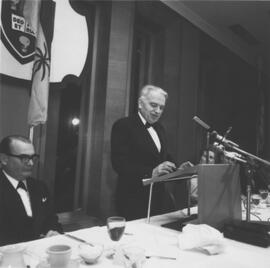Staff of the Indian and Northern Education Program (from l to r): Doris Sparvier; Dr. A.W. Blue, associate professor, Education (Indian and Northern Education); and Fr. André Renaud, chairman, Indian and Northern Education Program (Special Education), chat in Fr. Renaud's office in the Education Building.
Bio/Historical Note: Doris Sparvier was born in 1947 in Moose Jaw, Saskatchewan, and graduated from Albert E. Peacock High School in Moose Jaw. She graduated from the University of Saskatchewan with a BEd from the Indian Teacher Education Program (ITEP). Sparvier retired from the Saskatoon Public School Board in 2013 and later became a Dakota Language Instructor at the First Nations University of Canada (FNUC). Sparvier died in Saskatoon in 2018.
Bio/Historical Note: Concern over high turnover of teachers in northern communities, and in particular the high drop-out rate for First Nations students, led to the establishment of a special course, first offered in the summer of 1961. EDIND 357, “The School Program in Indian and Northern Communities,” was offered in conjunction with the College of Education. The first instructor was Father André Renaud (1920-1988), professor of Education. By 1962 another course had been added to summer session, and a course offered during regular term on the Saskatoon campus and in Prince Albert; and by 1964, a B.Ed. program had been established. An M.Ed. program was introduced in 1968.

